These are exactly what you shouldn’t be doing if you want to harness the power of Pinterest.
In case you weren’t aware, Pinterest has massive potential for driving blog traffic. And I’m not talking short-lived, low-quality traffic. I’m talking long-term, highly engaged traffic that can be a total game-changer for your blog.
The best part about Pinterest traffic is that it’s actually easier to gain than many of the other social networks. If you properly invest your time into working Pinterest, the returns can be much greater than that same amount of time put into other networks.
You want to keep one thing in mind though—there are two avenues to making Pinterest a successful social media channel for your blog.
- On Pinterest: this is the degree of success your account has on Pinterest (ie. followers, repins, likes, etc.)
- On your blog: this is the degree of success your blog has on Pinterest (ie. traffic, people pinning your articles, etc.)
So in this post I’m going to give you some of the things that could be holding you back from experiencing huge success for your blog on Pinterest. These are things I see many bloggers doing and whether it’s because someone told them so or they’re just unaware of doing them, they need to be stopped.
Success Killers On Pinterest
The following are things that you should never do, or stop doing, on your own Pinterest profile immediately. They are unhelpful, counter-productive (and you know I love me some productivity), or completely useless to gaining success on Pinterest.
Pinning Junky Pins
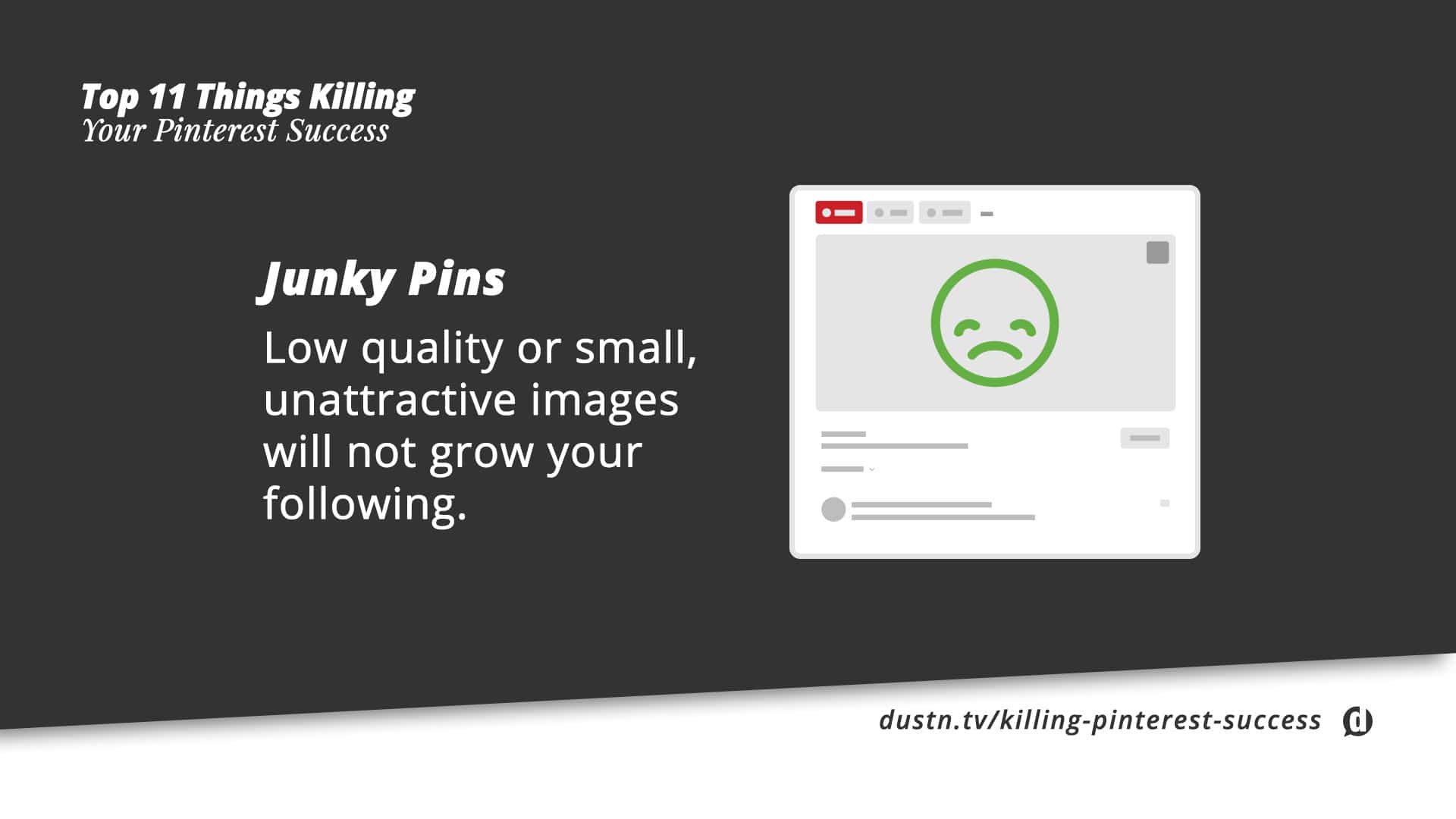
If you want people to follow and engage with you on Pinterest, you need to be pinning things worth following and engaging. This seems obvious but without being aware of what a “junky” pin is, you may doing this without knowing.
A junky pin is a pin that is:
- Visually unattractive: Use tall images with good imagery rather than short, small images that look low-quality
- Doesn’t go to the right place: Nothing is worse than clickin on a pin and being taken to a website that is not what you expected—or worse, an error page
- Out of context: Make sure you’re pinning things in relevant boards
Not only will these junky pins decrease your engagement and follow-worthiness of your account, but it will devalue you in Pinterest’s eyes. They are constantly working to rank and suggest high-quality pins and boards, so treat your boards as a museum curator would treat a precious collection.
Bad Pin Descriptions
Did you know that Pinterest is actually more of a Search Engine than a Social Network? Yea, true story.
So stop being lazy with your descriptions. This alone may be stifling your Pinterest growth. Pin descriptions are what allows your pins to be surfaced when someone searches Pinterest.
A well-though description is an indicator of a high-quality pin because it means the person who pinned it spent some time on it. Additionally, more words in the description means more reasons for it to match search queries.
Hashtags in Descriptions
Hashtags are not a thing in Pinterest. Period. Stop using them and focus on actually being descriptive instead.
At one point in time hashtags were clickable inside of the Pinterest user interface. This is no longer the case. In fact, as of now, the next version of the user interface (slowly rolling out at the time of this post) doesn’t even allow clicking on descriptions to see it in full.
So the only way someone would get to a list of recommended pins with one specific hashtag is to search for the hashtag.
Even if someone does decide to search for a hashtag (which people don’t do) the hashtag search algorithm is notoriously bad. The searches will return results so poor that the user is likely to never search a hashtag again.
By using hashtags you’re wasting time you could have spent creating a good description with actual keywords. Which brings me to my next point.
Not Using Keywords in Board Names and Descriptions
The following tip was brought to you by Peg Fitzpatrick.
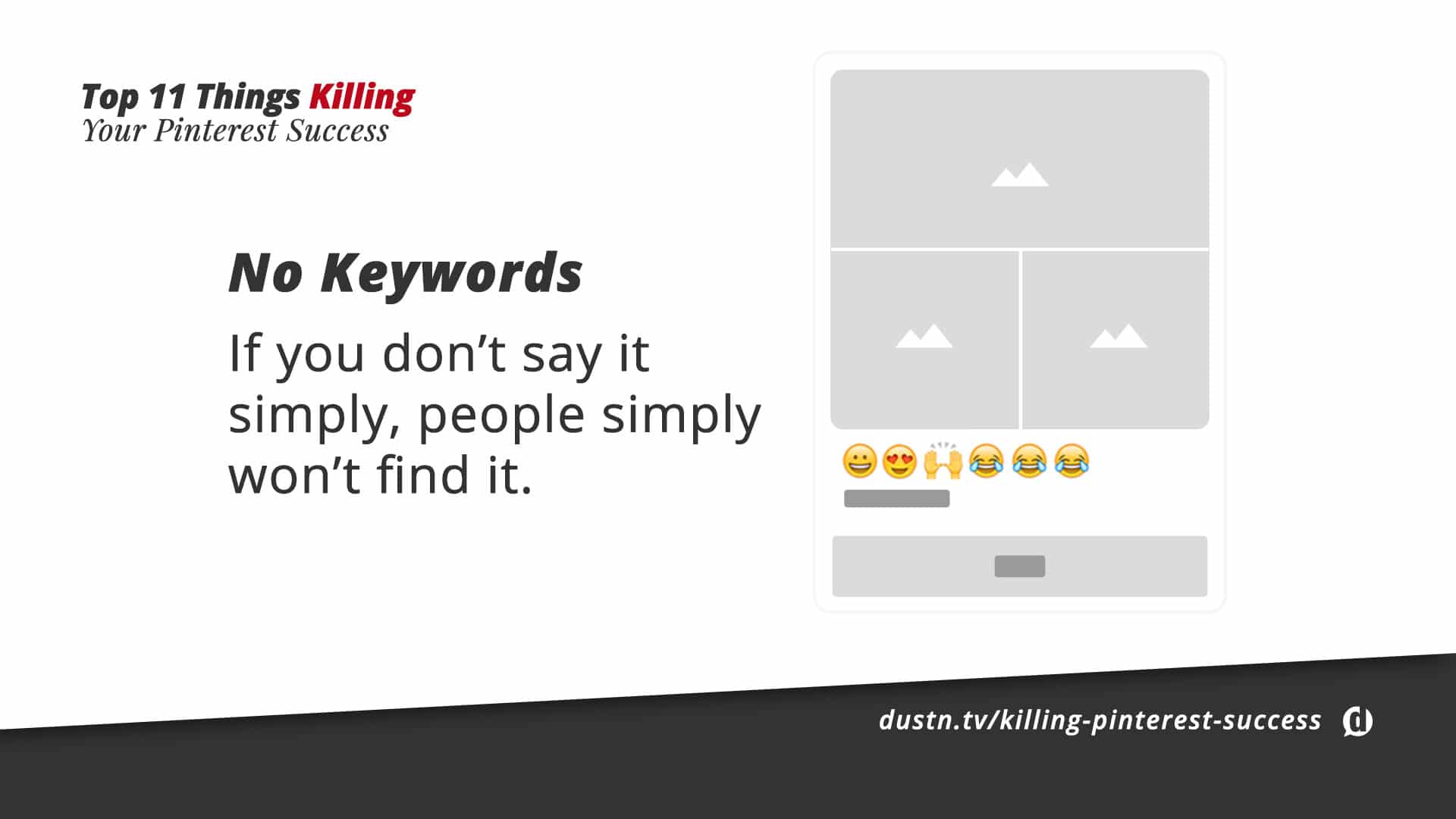
Look, I know you’re super creative and you want to name your board something unique. That’s all well and good, but make sure that it has some sort of keyword in both the title and description.
For example, if you’ve got a board named Nectar of the gods and a description of “Caffeinated delights to make your heart sing” nobody is going to know that this board is about Coffee. You have to, in some way, add in the keyword(s) that your board is about so that when people are searching for it, they will find it.
You don’t have to turn into an SEO nut and start keyword stuffing the heck out of your boards. Just make sure that a human can understand, in plain English, what the core subject matter of your board is.
This can also apply to your pin descriptions. If you’ve put good keywords into your well-written descriptions, you (again) have no reason to think that adding hashtags will be of use.
Forgetting to Add a Category to Your Boards
This tip brought to you by Kim Vij of The Educators’ Spin On It.
Just like the idea of keywords in your board names and descriptions, it’s crucial to select a category for your boards. This helps Pinterest to more accurately serve up your boards and pins to people who are looking for things in that category.
Now, sometimes your board won’t fit 100% into a category, but you need to pick one anyways. Find the most related category you can and choose it. It’s better to have selected the category yourself than to have Pinterest decide for you.
Deleting your pins

Maybe you heard some great pinner that you idolize share how they’ve had success on Pinterest doing X, Y, and Z. Inside this article, they detail that one of the things they’ve done is gone through and deleted “low-performing” pins.
What a complete waste of time.
Not only does this take up the valuable time you could have used for creating high-quality pins or engaging with people on the platform, you’re doing something that Pinterest itself has warned against!
Now, I don’t meant to demean those pinners who have said to do this. The problem is that most of the people telling you to do things to become successful on social media have not had any formal marketing training. What they may not be aware of is that you can’t attribute success of an isolated action when you’re performing other simultaneous actions that will affect the outcome.
In other words, if you’re experimenting with 5 things to see if it makes you more successful and you reach your goal, it doesn’t mean that all 5 things were the cause. It could have been one particular thing that moved the needle in the direction you were looking for.
So, suffice to say, stop deleting pins.
Inconsistent Pinning and Going on “Sprees”
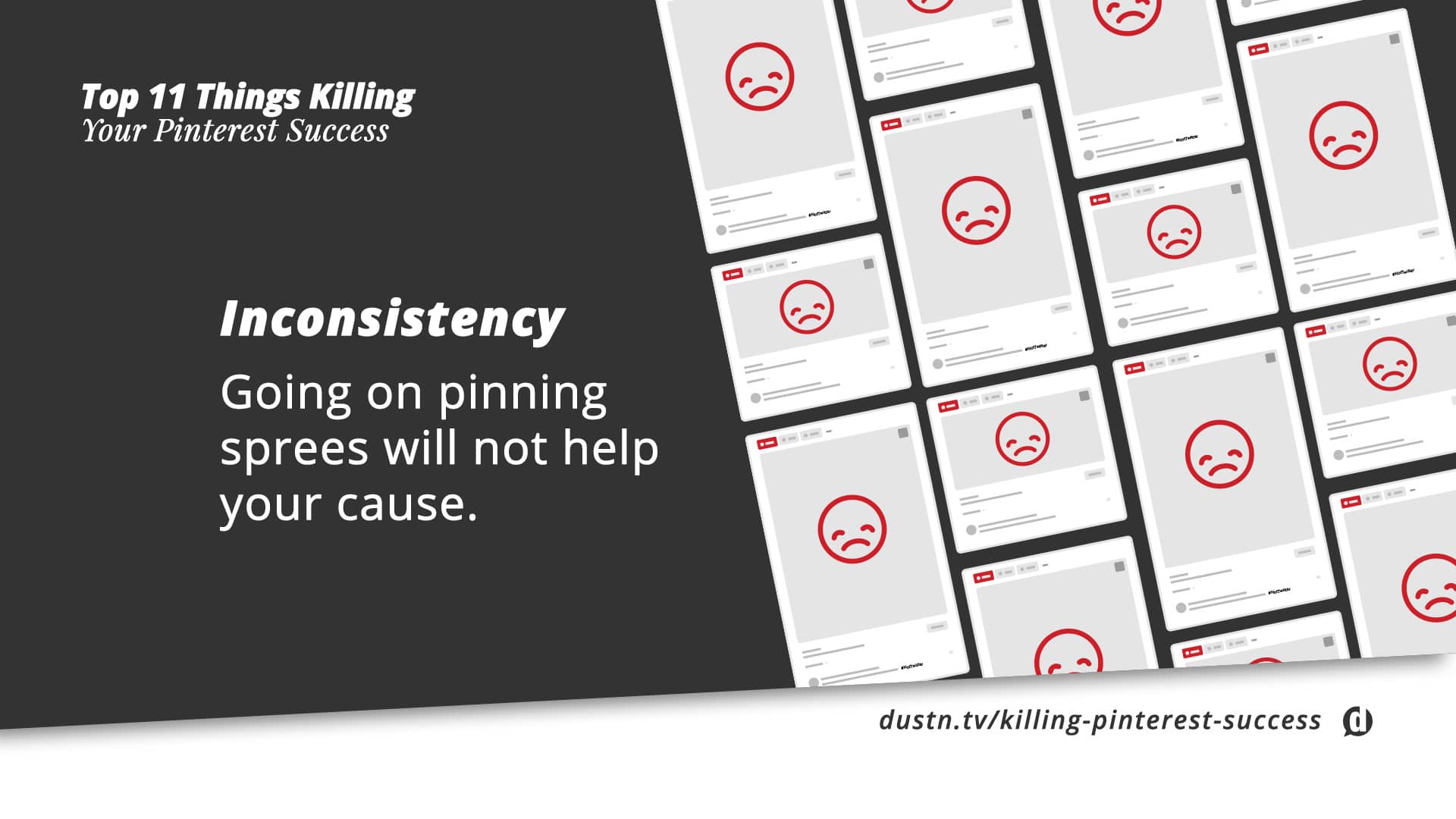
Success in anything is about consistency. In social media, you don’t want to blast people’s social feeds like a fire hose because they’ll quickly tune you out.
With Pinterest, going on a pinning spree, pinning all the things to all the boards for an hour one day and then never coming back for a couple weeks will kill your success. Instead, be consistent. Set a daily goal of pins (recommended 15-20 max) and stick to it.
Think of your Pinterest health like your personal health– it’s an apple a day, not 10 apples on Wednesday to make up for the last 9 days you’ve missed.
You can use tools like Buffer, Coschedule, or Tailwind to schedule your Pins if you want to go on bulk pinning sprees. These tools will allow you to schedule out your pins over time so that you’re not bombarding people’s feeds and your account stays consistently active.
This tip was also brought to you by Peg Fitzpatrick.
Success Killers On your blog
Moving beyond your own Pinterest profile, you want to make sure your website is optimized for Pinterest users when they come to read your blog. Hopefully you want to scale your effort beyond yourself by getting other people to pin your articles, right?
So be sure you’re not making the following mistakes on your blog.
Not Creating Optimized Images
It was Peg Fitzpatrick that finally convinced me to make a tall, Pinterest-specific image for every blog post. After my initial experiment with this resulted in 400% increase in traffic in 30-days, I’ll never not create a tall Pinterest image for a blog post.
Yes, I just used a double-negative Mr. Grammar Nazi. Get over it.

Savvy Pinterest users know what a good pin looks like, and it must be taller than it is wide (minimum of 735×1,102 pixels). So make sure that you have a pin-worthy image ready for them.
Grab my Pinterest image template below.
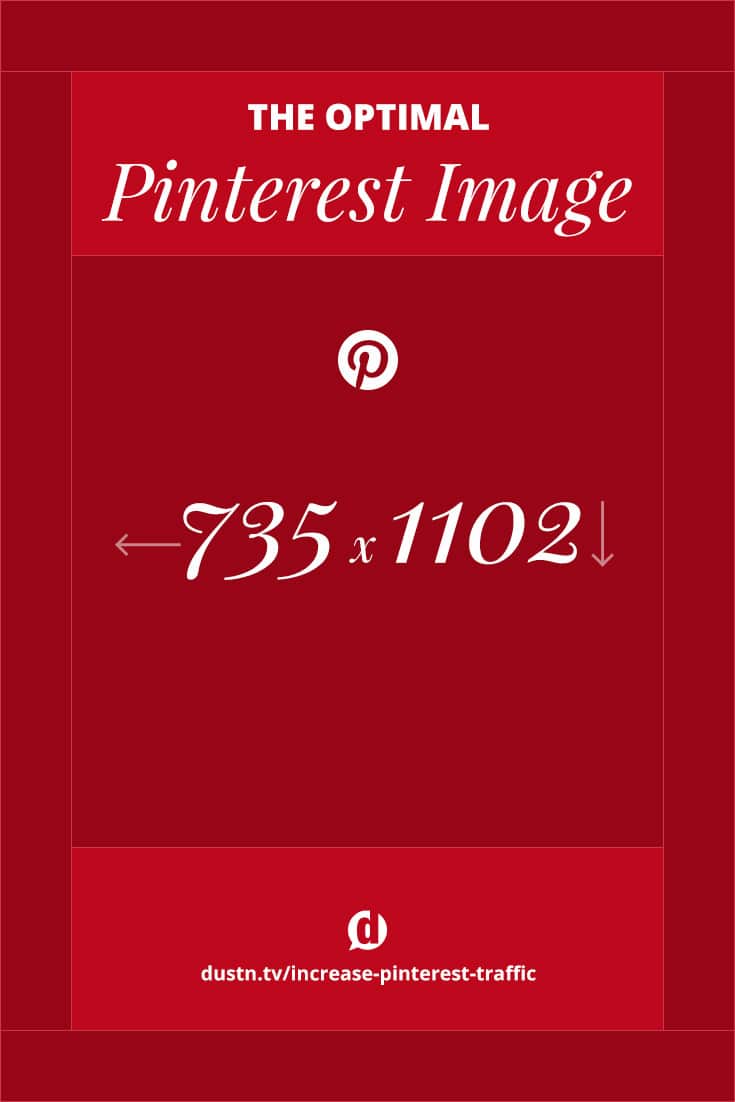
[Click for full size and “Save image as” somewhere safe.]
Just pull that image into your visual content app of choice and create your awesome visual right over top of it.
Making It Easy to Pin the Wrong Image
This is a tip that some people will not like. But I don’t care if you like it or not, I want you to be successful.
Too many bloggers believe that if they give their readers more options they will get better results. This couldn’t be further from the truth.
The psychological principle of the Paradox of Choice has proven that more options lead to less actions. Anyone who has spent some time researching Conversion Rate Optimization knows that if you want people to take a desired action, eliminate all other options.
So if you want people to pin your Pinterest-optimized images (because you know these images get more traffic) then make sure that you don’t make it easy to pin images that are not your Pinterest image. This means get rid of Pinterest plugins or apps that allow people to pin other images.
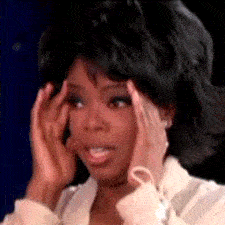
Yea, I said it. Get rid of your Image “Pin it” buttons. That is–the Pin buttons that show up when someone hovers over the images in your blog post.
Look, in order to increase your chances of success, you have to assume your readers are not Pinterest savvy power-users who are going to masterfully craft their pin so it drives mass amounts of traffic back to you. You have to assume they’re going to pin the first/easiest thing that they see.
So why make it easier to pin low-quality or non-optimized images? Trust me, this is destroying your website’s chances at more Pinterest traffic. People are pinning the wrong images and getting less click-through because of it.
In another post I’ve given you two ways to make it as easy as possible for Pinners to Pin your optimal image. One way is by using some HTML and the other way is by using Social Warfare.
Either way, stop making it easy for people to pin the wrong images.
Mobile Unfriendly Images
The following tip was courtesy of Jeff Sieh, the host of Manly Pinterest Tips.
So maybe you’re creating Pinterest-optimized images for your posts. Awesome! But are they passing the mobile readability test?
Did you know that as much as 80% of Pinterest’s traffic is mobile? Inside sources say it’s even more than that. So it is critically important that your pinnable images be mobile friendly.
Nothing is worse than coming across a pin that I can’t even read on my mobile device.
So stop making Pinterest images that are illegible on mobile phones. All you need to do is check the image on your own mobile phone first. If you can’t read what it says, nobody else can. And if you’re not able to stay objective, just hand your phone over to the nearest literate person and ask if they can read it.
Simple, right?
Making It Easy to Pin Bad Descriptions
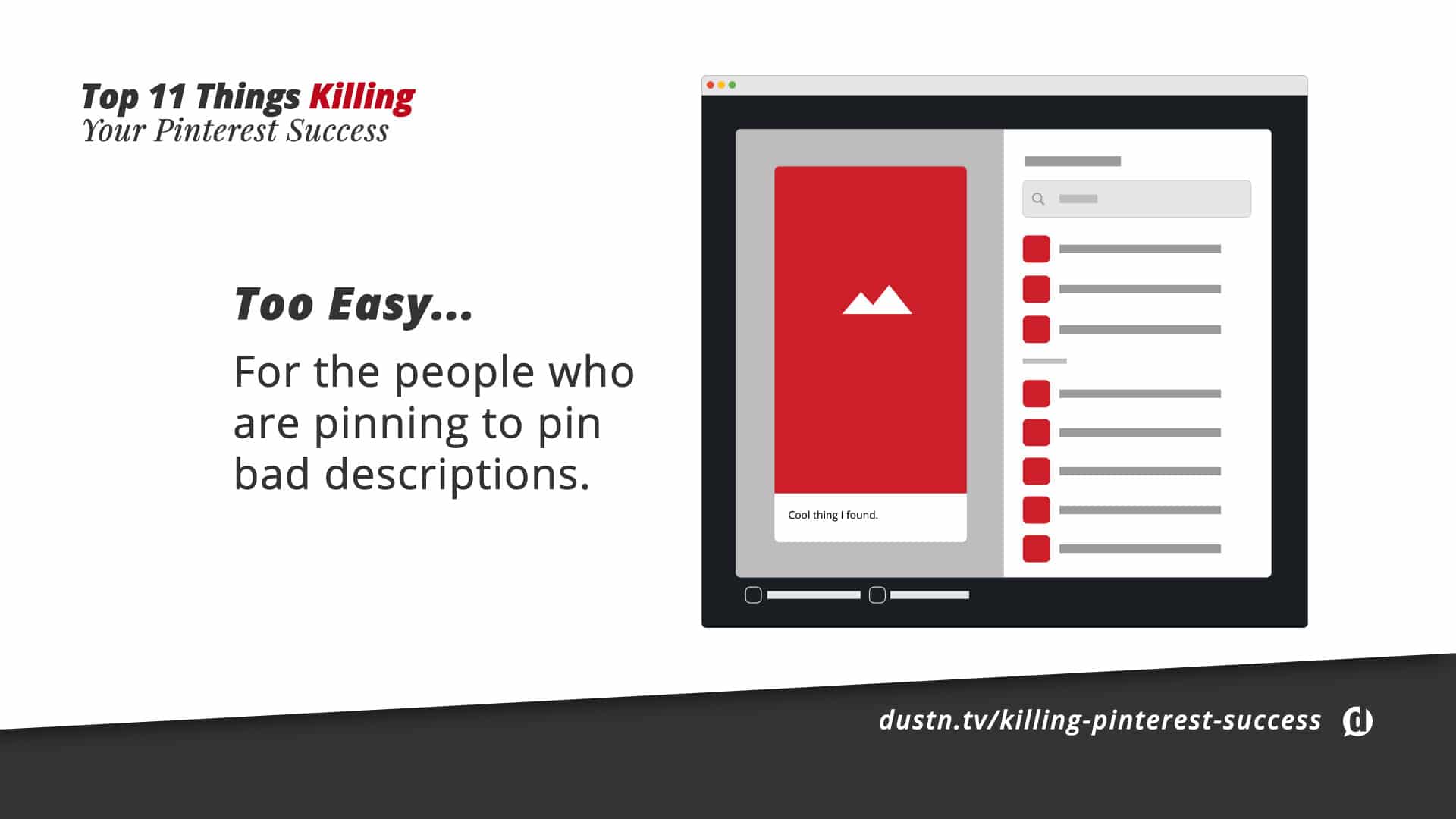
Back on the search thing, you know how important good descriptions are. But you can’t always count on the people pinning your content to write great descriptions. So what you want to do is write it for them.
This is another instance where the Social Warfare plugin shines, but if you don’t have it you can do the following:
- Fill out your image alt tags
- Fill out your image descriptions
Recommended Reading: How to Create Optimized Social Media Images
Filling this data out for people will automatically populate the pin description when they go to pin it. Now, they can choose to change the description if they like, but at least you’ve done what you can to give them a head-start.
Bonus: The Infographic
For reading all the way to the end, you get to see the full-length pin-friendly version of this post. You can even embed it right into your own website!

If you want to embed this infographic on your own site, copy and paste the embed code below.
<a href="https://dustinstout.com/killing-pinterest-success/"><img src="https://dustinstout.com/wp-content/uploads/2016/09/11-things-killing-pinterest-success-dustntv.jpg" alt="Top 11 Things Killing Your Pinterest Success" width="600px" border="0"/></a><em>Image courtesy of <a href="https://dustinstout.com">dustinstout.com</a></em>
Now Be Pinterest Awesome!
The ball is now in your court. Take this advice and apply it to your Pinterest efforts and watch your profile and blog traffic grow!
Is there any other annoying or counter-productive Pinterest behavior that I’ve left out? You can let me know in the comments below.
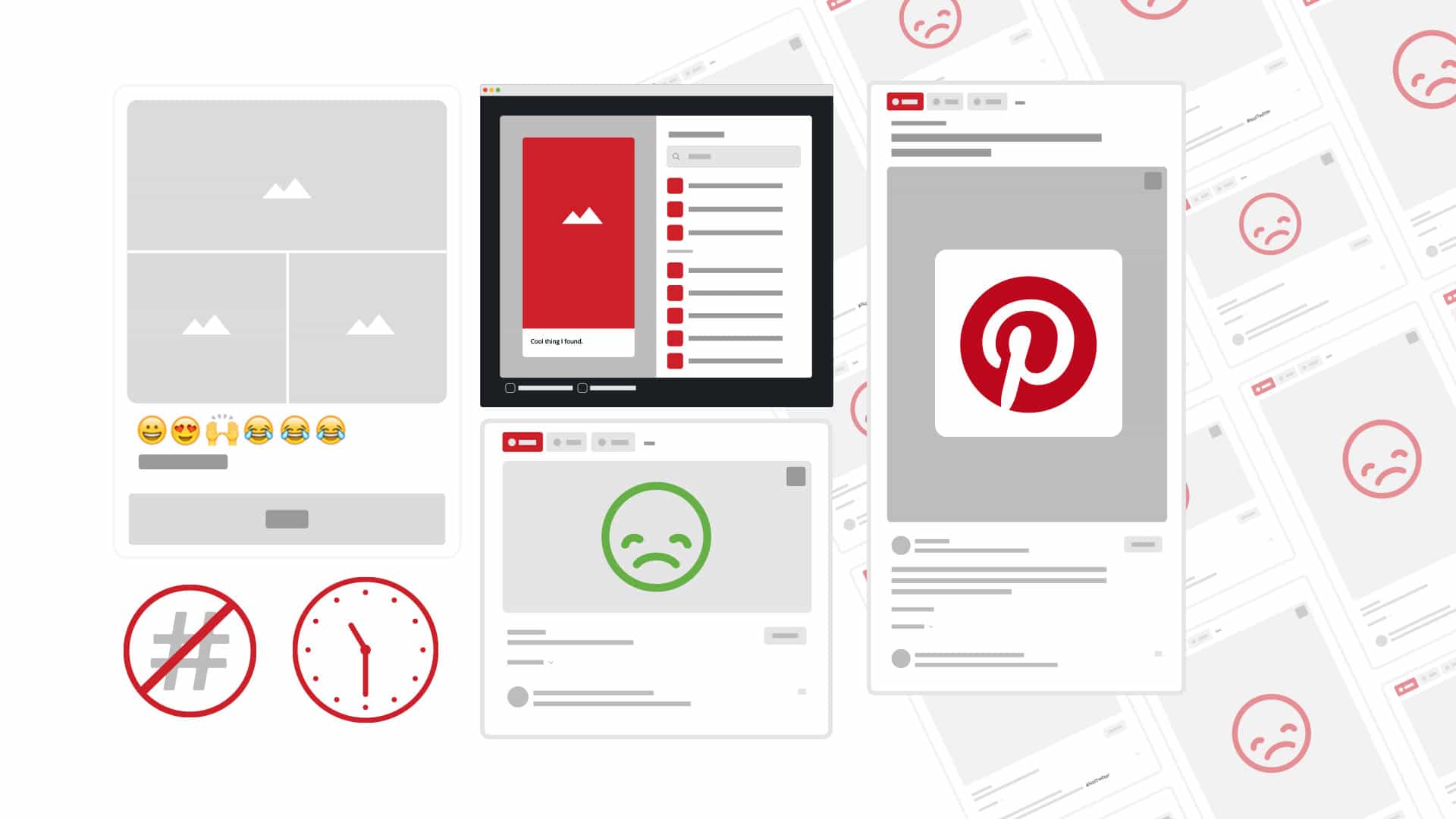
Leave a Reply
You must be logged in to post a comment.